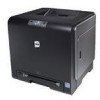Dell 1320c User Guide - Page 38
Print Media Guidelines - black toner
 |
UPC - 662919013061
View all Dell 1320c manuals
Add to My Manuals
Save this manual to your list of manuals |
Page 38 highlights
back to contents page Print Media Guidelines Print media is paper, labels, envelopes, and coated paper among others. Your printer provides high-quality printing on a variety of print media. Selecting the appropriate print media for your printer helps avoid printing troubles. This section describes selecting print media, caring for print media, and loading the print media in the tray 1. Paper Envelopes Labels Storing Print Media Identifying Print Media Sources and Specifications Paper For the best print quality in color, use 75 g/m2 (20 lb) xerographic, grain long paper. For the best print quality in black and white, use 90 g/m2 (24 lb) xerographic, grain long paper. Before buying large quantities of any print media, Dell recommends trying a sample first. When loading paper, identify the recommended print side on the paper package, and load the paper accordingly. See "Loading Print Media in Tray 1" and "Loading the Single Sheet Feeder" for detailed loading instructions. Paper Characteristics The following paper characteristics affect print quality and reliability. Dell recommends that you follow these guidelines when evaluating new paper stock. Weight The tray automatically feeds paper weights from 60 to 216 g/m2 (16 to 60 lb bond) grain long. The single sheet feeder automatically feeds paper weights from 60 to 216 g/m2 (16 to 80 lb bond) grain long. Paper lighter than 60 g/m2 (16 lb) may not feed properly, and could cause paper jams. For best performance, use 75 g/m2 (20 lb bond) grain long paper. Curl Curl is the tendency of print media to curve at its edges. Excessive curl can cause paper feeding problems. Curl usually occurs after the paper passes through the printer, where it is exposed to high temperatures. Storing paper unwrapped, even in the paper tray, can contribute to paper curling prior to printing and cause feeding problems regardless of humidity. When printing on curled paper, straighten the paper and then insert it into the single sheet feeder. Smoothness The degree of paper smoothness directly affects print quality. If the paper is too rough, the toner does not fuse to the paper properly, resulting in poor print quality. If the paper is too smooth, it can cause paper feeding problems. Smoothness between 150 and 250 Sheffield points produces the best print quality. Moisture Content The amount of moisture in the paper affects both print quality and the ability of the printer to feed the paper properly. Leave the paper in its original packaging until you are ready to use it. This limits the exposure of the paper to moisture changes that can degrade its performance. Grain Direction Grain refers to the alignment of the paper fibers in a sheet of paper. Grain is either grain long, running the length of the paper, or grain short, running the width of the paper. For 60 to 135 g/m2 (16 to 36 lb bond) paper, grain long fibers are recommended. For papers heavier than 135 g/m2 (36 lb bond), grain short is preferred. Fiber Content















